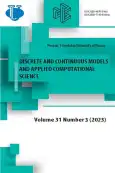Brain-computer interaction modeling based on the stable diffusion model
- Autores: Shchetinin E.Y.1
-
Afiliações:
- Financial University under the Government of the Russian Federation
- Edição: Volume 31, Nº 3 (2023)
- Páginas: 273-281
- Seção: Articles
- URL: https://journal-vniispk.ru/2658-4670/article/view/315345
- DOI: https://doi.org/10.22363/2658-4670-2023-31-3-273-281
- EDN: https://elibrary.ru/KPCBBQ
- ID: 315345
Citar
Texto integral
Resumo
This paper investigates neurotechnologies for developing brain-computer interaction (BCI) based on the generative deep learning Stable Diffusion model. An algorithm for modeling BCI is proposed and its training and testing on artificial data is described. The results are encouraging researchers and can be used in various areas of BCI, such as distance learning, remote medicine and the creation of robotic humanoids, etc.
Palavras-chave
Sobre autores
Eugeny Shchetinin
Financial University under the Government of the Russian Federation
Autor responsável pela correspondência
Email: riviera-molto@mail.ru
ORCID ID: 0000-0003-3651-7629
Doctor of Physical and Mathematical Sciences, Lecturer of Department of Mathematics
49, Leningradsky Prospect, Moscow, 125993, Russian FederationBibliografia
- W. Li, Y. Chen, X. Huang, G. Wang, and X. Zhang, “Combining multiple statistical methods to improve EEG-based decoding for BCI applications,” Applications. IEEE Transactions on Instrumentation and Measurement, vol. 69, no. 12, pp. 8896-8906, 2019.
- C. Yen and C. Lin, “A real-time brain-computer interface system for the upper limb using feedback training based on motor imagery,” IEEE Transactions on Neural Systems and Rehabilitation Engineering, vol. 27, no. 10, pp. 2087-2096, 2019.
- H. Zhang, W. Zheng, K. Zhang, Y. Li, Y. Wang, and L. Yao, “Stochastic channel effects modeling and training deep spiking neural networks for brain-computer interface,” IEEE Transactions on Neural Networks and Learning Systems, vol. 31, no. 2, pp. 350-364, 2019.
- D. Zhu, J. Bieger, and A. Datta, “Brain-computer interfaces in neurorehabilitation: a review of recent progress,” IEEE Transactions on Neural Systems and Rehabilitation Engineering, vol. 27, no. 6, pp. 1319-1339, 2019.
- D. Wu, B. Wang, Y. Li, J. Shen, and G. Wang, “A review of EEG-based brain-computer interface for medical robotic system control,” IEEE Transactions on Neural Systems and Rehabilitation Engineering, vol. 28, no. 6, pp. 1233-1244, 2020.
- S. Bhattacharya, “A brief review of brain-computer interface for neuropsychological rehabilitation,” IEEE Reviews in Biomedical Engineering, no. 12, pp. 95-107, 2019.
- X. Li, D. Zhu, H. Chen, Y. Zhang, and X. Wu, “A BMI system for rehabilitation of hemiplegic patients based on transcranial direct current stimulation and affective feedback,” IEEE Transactions on Neural Systems and Rehabilitation Engineering, vol. 27, no. 3, pp. 535-544, 2019.
- Z. Liu, Y. Li, L. Cheng, Q. Zhang, M. Wang, L. Kong, and Y. Wang, “An EEG-based brain-computer interface system for independent living of people with cerebral palsy,” IEEE Journal of Biomedical and Health Informatics, vol. 24, no. 7, pp. 1927-1935, 2020.
- Y. Hu, Y. Hou, M. Wang, T. Yu, and J. Zhang, “EEG-based motor imagery BCI system via supervised joint blind source separation and convolutional neural network,” IEEE Transactions on Neural Systems and Rehabilitation Engineering, no. 29, pp. 1586-1597, 2021.
- G. Choi, W. Ko, Y. Jung, S. Jo, K. Kim, and S. Lee, “A review on recent progress in EEG-based brain-computer interface for assistive robotic control,” IEEE Reviews in Biomedical Engineering, no. 12, pp. 141-157, 2019.
- M. Rashid, J. Höhne, G. Schmitz, and G. Müller-Putz, “A review of humanoid robots controlled by brain-computer interfaces,” Frontiers in Neurorobotics, no. 14, pp. 1-28, 2020.
- J. Ho, A. Jain, and P. Abbeel, Denoising diffusion probabilistic models, 2020. doi: 10.48550/arXiv.2006.11239.
- P. Dhariwal and A. Nichol, Diffusion models beat GANs on image synthesis, 2021. doi: 10.48550/arXiv.2105.05233.
- R. Rombach, A. Blattmann, D. Lorenz, P. Esser, and O. B., Highresolution image synthesis with latent diffusion models, 2021. doi: 10.48550/arXiv.2112.10752.
- A. Blattmann, R. Rombach, K. Oktay, and B. Ommer. “Latent diffusion models.” (2022), [Online]. Available: https://github.com/CompVis/latent-diffusion.
- J. Sohl-Dickstein, E. A. Weiss, N. Maheswaranathan, and S. Ganguli, Deep unsupervised learning using nonequilibrium thermodynamics, 2015. doi: 10.48550/arXiv.1503.03585.
- M. Welling and Y. W. Teh, “Bayesian learning via stochastic gradient Langevin dynamics,” in Proceedings of the 28th International Conference on International Conference on Machine Learning, ser. ICML’11, Madison, WI, USA: Omnipress, 2011, pp. 681-688. doi: 10.5555/3104482.3104568.
- J. Ho, A. Jain, and P. Abbeel, Denoising diffusion probabilistic models, 2020. doi: 10.48550/arXiv.2006.11239.
Arquivos suplementares









